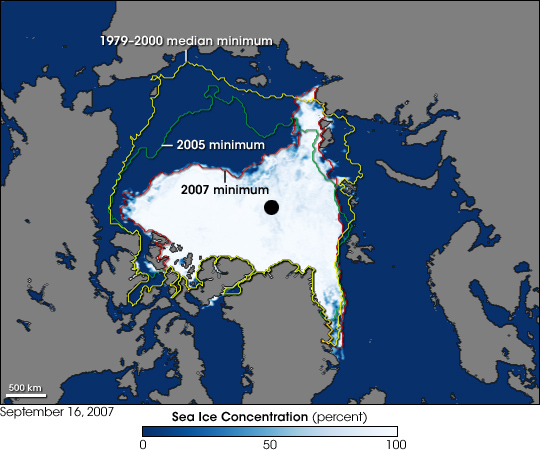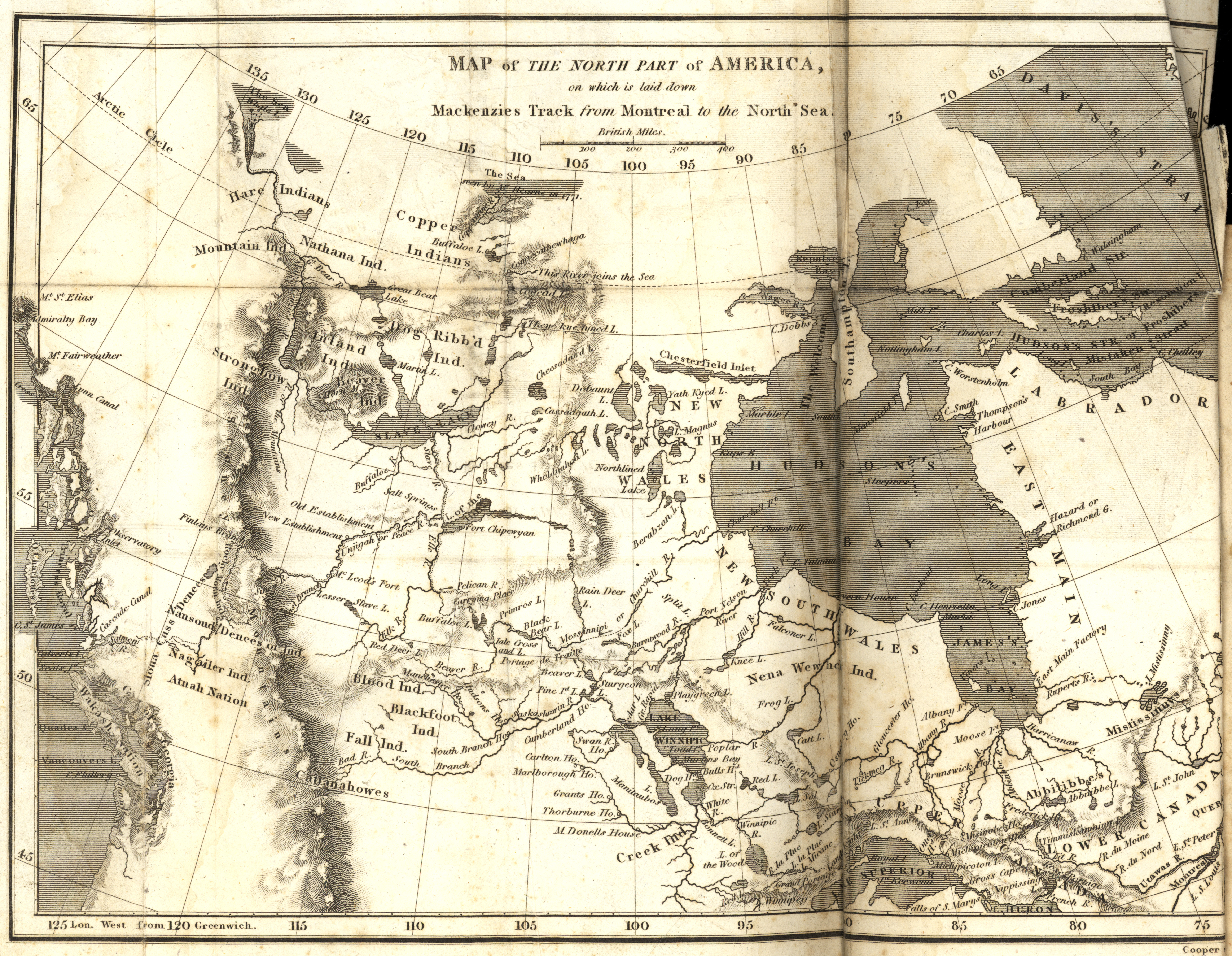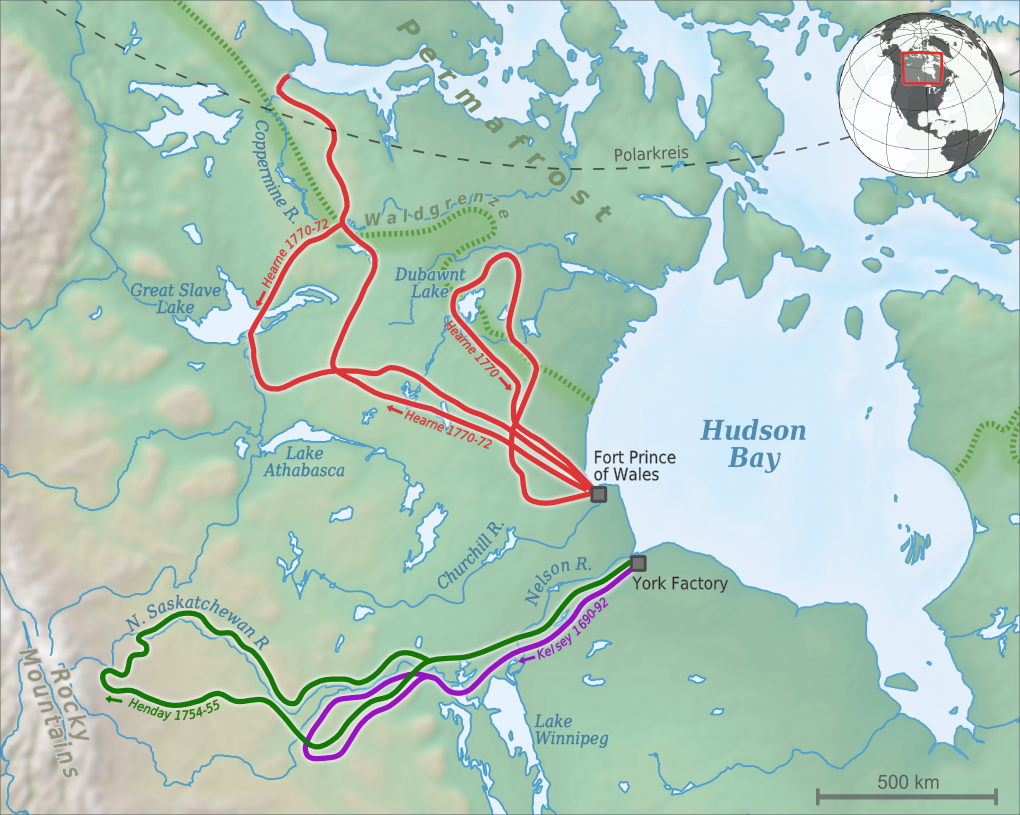|
Coppermine Expedition
The Coppermine expedition of 1819–1822 was a British overland undertaking to survey and chart the area from Hudson Bay to the north coast of Canada, eastwards from the mouth of the Coppermine River. The expedition was organised by the Royal Navy as part of its attempt to discover and map the Northwest Passage. It was the first of three Arctic expeditions to be led by John Franklin and also included George Back and John Richardson, both of whom would become notable Arctic explorers in their own right. The expedition was plagued by poor planning, bad luck and unreliable allies. The expected assistance from the local fur trading companies and native peoples was less forthcoming than expected, and the dysfunctional supply line, coupled with unusually harsh weather and the resulting absence of game, meant the explorers were never far from starvation. Eventually, the Arctic coast was reached, but barely had been explored before the exhaustion of the party's supplies and the onset ... [...More Info...] [...Related Items...] OR: [Wikipedia] [Google] [Baidu] |
Coppermine Expedition Map
Coppermine may refer, apart from the primary meaning of copper extraction, to: * Coppermine Bay, Greenland * Coppermine Herald, one of the heralds at the Canadian Heraldic Authority * Coppermine Peninsula, Antarctica * Coppermine Photo Gallery * Coppermine River, in Nunavut and the Northwest Territories * Kugluktuk, Nunavut, formerly known as Coppermine * Pentium III, a microprocessor code-named "Coppermine" {{disambig ... [...More Info...] [...Related Items...] OR: [Wikipedia] [Google] [Baidu] |
Sir John Barrow, 1st Baronet
Sir John Barrow, 1st Baronet, (19 June 1764 – 23 November 1848) was an English geographer, linguist, writer and civil servant best known for term as the Second Secretary to the Admiralty from 1804 until 1845. Early life Barrow was born the only child of Roger Barrow, a tanner in the village of Dragley Beck, in the parish of Ulverston, Lancashire.Prior to 1 April 1974 Ulverston was in Lancashire He was a pupil at Town Bank Grammar School, Ulverston, but left at age 13 to found a Sunday school for the poor. Barrow was employed as superintending clerk of an iron foundry at Liverpool. At only 16, he went on a whaling expedition to Greenland. By his twenties, he was teaching mathematics, in which he had always excelled, at a private school in Greenwich. China Barrow taught mathematics to the son of Sir George Leonard Staunton; through Staunton's interest, he was attached on the first British embassy to China from 1792 to 1794 as comptroller of the household to Lord Maca ... [...More Info...] [...Related Items...] OR: [Wikipedia] [Google] [Baidu] |
Spitsbergen
Spitsbergen (; formerly known as West Spitsbergen; Norwegian: ''Vest Spitsbergen'' or ''Vestspitsbergen'' , also sometimes spelled Spitzbergen) is the largest and the only permanently populated island of the Svalbard archipelago in northern Norway. Constituting the westernmost bulk of the archipelago, it borders the Arctic Ocean, the Norwegian Sea, and the Greenland Sea. Spitsbergen covers an area of , making it the largest island in Norway and the 36th-largest in the world. The administrative centre is Longyearbyen. Other settlements, in addition to research outposts, are the Russian mining community of Barentsburg, the research community of Ny-Ålesund, and the mining outpost of Sveagruva. Spitsbergen was covered in of ice in 1999, which was approximately 58.5% of the island's total area. The island was first used as a whaling base in the 17th and 18th centuries, after which it was abandoned. Coal mining started at the end of the 19th century, and several permanent com ... [...More Info...] [...Related Items...] OR: [Wikipedia] [Google] [Baidu] |
Open Polar Sea
The Open Polar Sea was a hypothesized ice-free ocean surrounding the North Pole. This unproved and eventually-disproved theory was once so widely believed that many exploring expeditions used it as justification for attempts to reach the North Pole by sea or to find a navigable sea route between Europe and the Pacific across the North Pole. History The theory that the North Pole region might be a practical sea route goes back to at least the 16th century, when it was suggested by English cartographer Robert Thorne (1492-1532). The explorers William Barents and Henry Hudson also believed in the Open Polar Sea. For a time, the theory was put aside because of the practical experience of navigators who encountered impenetrable ice as they went north. However, the idea was revived again in the mid-19th century by theoretical geographers, such as Matthew F. Maury and August Petermann. At the time, interest in polar exploration was high because of the search for John Franklin's missin ... [...More Info...] [...Related Items...] OR: [Wikipedia] [Google] [Baidu] |
North Pole
The North Pole, also known as the Geographic North Pole or Terrestrial North Pole, is the point in the Northern Hemisphere where the Earth's rotation, Earth's axis of rotation meets its surface. It is called the True North Pole to distinguish from the Magnetic North Pole. The North Pole is by definition the northernmost point on the Earth, lying antipode (geography), antipodally to the South Pole. It defines geodetic latitude 90° North, as well as the direction of true north. At the North Pole all directions point south; all lines of longitude converge there, so its longitude can be defined as any degree value. No time zone has been assigned to the North Pole, so any time can be used as the local time. Along tight latitude circles, counterclockwise is east and clockwise is west. The North Pole is at the center of the Northern Hemisphere. The nearest land is usually said to be Kaffeklubben Island, off the northern coast of Greenland about away, though some perhaps semi-per ... [...More Info...] [...Related Items...] OR: [Wikipedia] [Google] [Baidu] |
David Buchan
David Buchan (1780 – after 8 December 1838) was a Scottish naval officer and Arctic explorer. Family In 1802 or 1803, he married Maria Adye. They had at least three children. Exploration In 1806, Buchan was appointed as a lieutenant in the Royal Navy, and from about 1808 to 1817 he operated in and around Newfoundland. In 1810 he was captain of HMS ''Adonis''. In autumn 1810 he conducted an expedition to the River of Exploits. From there he and his men marched inland for 130 miles to establish contact with the dwindling native Beothuk population, one of the Indigenous peoples of the Americas in the region. The expedition resulted in the death and decapitation of two marines at their hands.William James Mills, ''Exploring Polar Frontiers: A Historical Encyclopedia'', ABC-CLIO, 2003; In 1813, ''Adonis'' and the frigate escorted the Newfoundland fishing fleet back to Britain. The voyage was stormy and the vessels separated near the English Channel. ''Adonis'' regained th ... [...More Info...] [...Related Items...] OR: [Wikipedia] [Google] [Baidu] |
Lancaster Sound
Lancaster Sound () is a body of water in the Qikiqtaaluk Region, Nunavut, Canada. It is located between Devon Island and Baffin Island, forming the eastern entrance to the Parry Channel and the Northwest Passage. East of the sound lies Baffin Bay; to the west lies Viscount Melville Sound. Further west a traveller would enter the M'Clure Strait before heading into the Arctic Ocean. The Inuit and their predecessors in the region, the Paleo-Eskimos, have relied for hundreds, perhaps thousands of years on the sound's abundant natural wealth for food, clothing and shelter. Today, residents of the three Nunavut communities of Pond Inlet, Arctic Bay, and Resolute continue this tradition, depending on its waters for their economic and cultural well being. History Lancaster Sound was named in 1616 by explorer William Baffin for Sir James Lancaster, one of the three main financial supporters of his exploratory expeditions. The abortive expedition by the British explorer John Ross in 181 ... [...More Info...] [...Related Items...] OR: [Wikipedia] [Google] [Baidu] |
John Ross (Arctic Explorer)
Sir John Ross (24 June 1777 – 30 August 1856) was a Scottish Royal Navy officer and polar explorer. He was the uncle of Sir James Clark Ross, who explored the Arctic with him, and later led expeditions to Antarctica. Biography Early life John Ross was born in Balsarroch, West Galloway, Scotland, on , the son of the Reverend Andrew Ross of Balsarroch, Minister of Inch in Wigtownshire, and Elizabeth Corsane, daughter of Robert Corsane, the Provost of Dumfries. His family home was on the shore of Loch Ryan, at Stranraer. Naval career In 1786, aged nine, Ross joined the Royal Navy as a first-class volunteer and was assigned to . It soon sailed to the Mediterranean Sea, where it remained until 1789. He then served aboard for several months before a transfer to the merchant marine for eight years. In September 1799 he was recalled to the Navy and appointed midshipman on HMS ''Weazel'', which shortly joined in the Anglo-Russian invasion of Holland. Short per ... [...More Info...] [...Related Items...] OR: [Wikipedia] [Google] [Baidu] |
Alexander Mackenzie (explorer)
Sir Alexander Mackenzie (or MacKenzie, gd, Alasdair MacCoinnich; – 12 March 1820) was a Scottish explorer known for accomplishing the first crossing of America north of Mexico in 1793. The Mackenzie River is named after him. Early life Mackenzie was born in House in Stornoway in Lewis. He was the third of the four children born to Kenneth 'Corc' Mackenzie (1731–1780) and his wife Isabella MacIver, from another prominent mercantile family in Stornoway. When only 14 years old, Mackenzie's father served as an ensign to protect Stornoway during the Jacobite rising of 1745. He later became a merchant and held the tack of Melbost; his grandfather being a younger brother of Murdoch Mackenzie, 6th Laird of Fairburn. Educated at the same school as Colin Mackenzie, the army officer and first Surveyor General of India, he sailed to New York City with his father to join an uncle, John Mackenzie, in 1774, after his mother died in Scotland. In 1776, during the American War of I ... [...More Info...] [...Related Items...] OR: [Wikipedia] [Google] [Baidu] |
Samuel Hearne
Samuel Hearne (February 1745 – November 1792) was an English explorer, fur-trader, author, and naturalist. He was the first European to make an overland excursion across northern Canada to the Arctic Ocean, actually Coronation Gulf, via the Coppermine River. In 1774, Hearne built Cumberland House for the Hudson's Bay Company, its second interior trading post after Henley House and the first permanent settlement in present Saskatchewan. Biography Samuel Hearne was born in February 1745 in London. Hearne's father was Secretary of the Waterworks of London Bridge, who died in 1748. His mother's name was Diana, and his sister's name was Sarah, three years younger than Samuel. Samuel Hearne joined the British Royal Navy in 1756 at the age of 11 as midshipman under the fighting captain Samuel Hood. He remained with Hood during the Seven Years' War, seeing considerable action during the conflict, including the bombardment of Le Havre. At the end of the Seven Years' War, having serve ... [...More Info...] [...Related Items...] OR: [Wikipedia] [Google] [Baidu] |
Canadian Arctic Archipelago
The Arctic Archipelago, also known as the Canadian Arctic Archipelago, is an archipelago lying to the north of the Canadian continental mainland, excluding Greenland (an autonomous territory of Denmark). Situated in the northern extremity of North America and covering about , this group of 36,563 islands, surrounded by the Arctic Ocean, comprises much of Northern Canada, predominately Nunavut and the Northwest Territories. The archipelago is showing some effects of climate change, with some computer estimates determining that melting there will contribute to the rise in sea levels by 2100. History Around 2500 BCE, the first humans, the Paleo-Eskimos, arrived in the archipelago from the Canadian mainland. Between 1000–1500 CE, they were replaced by the Thule people, who are the ancestors of today's Inuit. British claims on the islands, the British Arctic Territories, were based on the explorations in the 1570s by Martin Frobisher. Canadian sovereignty was originally ( ... [...More Info...] [...Related Items...] OR: [Wikipedia] [Google] [Baidu] |





.jpg)



